#anyway sorry none of them are really 'crazy whirlwind of passion'
Explore tagged Tumblr posts
Note
HMMMM okay ROs description as lover? what's being in relationship is like for them? or what it's like to be in a relationship with them?
hmm gotta keep this spoiler free.. welp this is kind of jumping the gun a bit since i think established relationship wont be until book 2, but:
Maria:
She’s been self-sufficient for a long time; long enough that learning she can rely on someone again is a process, but once she does she’s incredibly grateful. Her biggest thing is she wants a teammate, and that’s what she’d try to be for her partner more than anything else. If it’s the just the two of them against the world, that’s just fine by her, because that’s all she needs anyway.
Tad:
He thrives on companionship but really doesn’t have many people he’s emotionally open with–he acts as the emotional support more often than not, so having someone who he can be open and honest with, through good and bad, is something he cherishes. If anyone in the group believes in soulmates, its probably Tad, and that’s what a relationship with him would be like. More good times than bad, more gradual intimacy than explosive passion.
Greer:
They’re very independent–enough that they’re really not the sort to actively seek out relationships. Whatever level of commitment their partner wants is fine with them. They want someone who accepts them for who they are, and they will do the same for their partner, flaws and all. They want someone they can be themselves around, who can understand them and will be a friend before anything else, because in their mind, friendship is ultimately what separates a true romance from just another one-night stand.
Amy:
She’s a bit of a contradictory lover; a realist and a romantic. She dreams of the moments where she’ll be swept off her feet and slow-dancing to nothing, but knows that can’t be everyday. So a partner with a streak of romantic spontaneity would really be a great match for her. She tries to be incredibly considerate of others, and her partners are no exception to that, and she’s always willing to be patient and listen, meaning almost all conflicts end in gentle discussion instead of screaming.
Darwin:
He never really thought he’d ever have a long-term partner, so having someone in that role is a bit of a first for him. He’s extra-adept at recognizing the areas where his partner is better-informed or adjusted than he is and tries his best to follow their lead in those moments. Therefore, he’d like it if his partner was able to do the same for him. He doesn’t need grand romantic gestures or eternal promises of loyalty, just someone who he can tag-team with him and balance him out. In turn, he will try to be the same for them.
Cain:
He’s had enough excitement for two lifetimes, so all he really wants now is someone he can spend some quiet time with. As long as he can enjoy his partner’s company and they can enjoy his, that’s what matters. He doesn’t need (or want) to do everything together–especially if it’s not a shared interest–and is totally content sitting in silence, just vibing. Not the most exciting, perhaps, but that just makes the moments of impulsive romance all the more memorable.
#(takes notes for myself)#anyway sorry none of them are really 'crazy whirlwind of passion'#thats for the honeymoon phase#hopefully this answered the question..#i reread some of these and im like 'wtf this is so ramble-y what are you saying'
43 notes
·
View notes
Text
50 Things I Learned Before Med School and then Compared to the Real Thing.
A little more than 4 years ago I wrote a 50 things-thing before I started medical school based solely off the things I was told by other people which was a lot of fun considering I wasn’t actually doing it yet. Now having basically completed my own whirlwind adventure I can go back and see if what I wrote on nothing but hearsay actually ended up being the truth.
I’ve literally waited so long to do this. Hope you enjoy.
First year
This is hardest you will have ever done. So far. – At this point in my life, yes, the first year of medical school tore me apart. But it put me back together, in way.
Even though it seems like you have no time, you really do. Now is the time to go to social events and make friends. – Part of the whole process is finding companionship in commiseration.
Take pictures with everyone at your white coat ceremony. – So I ended up not being able to do this the way I wanted to back then, but you can bet your asses I’ve got this down for graduation.
Anatomy has three types of people on the first day; the people who are way too fascinated, the ones who cry because they are cutting open a person, and the people who throw up into the slop bucket. – No one threw up or passed out but it was A Thing no doubt about it.
Always flip the body slowly and with precision. Unless you want a formaldehyde and fat shower. – It was me. I got the shower. I had to throw away my shoes.
You might fail your first test. Cry a lot then get over it. – I didn’t, but that doesn’t mean I never did.
Even though you know everyone has to be smart on some level, all the drama and nonsense you still see is a little disappointing. – It made things more interesting. Kinda like reality TV.
You will spend your loan money on non-school items. Because you have no money. – Thank you, Amazon.
Invest in focus factor. – Never did, never needed it. Anxiety is a strong motivator y’all.
Sleep is for the weak. Caffeine is for the strong. – Wrong, I need sleep so badly all the time. Please sleep.
You’ll get really good at scheduling. MAKE yourself good at it. – I got really good the first few years. Like creepy good. But that only lasts so long.
Studying is completely different. If you undergrad it, you’re in trouble. – Too many of my classmates learned that IMMEDIATELY. I, on the other hand, always struggled so it was just the same but A LOT MORE.
You will completely lose track of time, days and pretty much the outside world. – I still don’t know what day it is.
You will horribly mess up at least once during standardized patient care practice. It will be hilarious for everyone except you. – More than once even.
This year will mark your very last real summer vacation. Use wisely. – Kind of, but not really. It’s the last significant one (if your school is kind) but there are plenty of other opportunities to live life.
Second year
Tears will be shed because you didn’t realize how good you had it in first year. – Not until January. That’s when you start missing first year. At least I did.
Every first year will somehow look like babies, no matter their age. – Very much yes. All so young, and full of hope.
At this point they want you to do other things. Like volunteering, research and be involved on campus. Do them and know that you can sleep when you’re dead. – They as in residencies. They do want fluff, good, passionate fluff. But please sleep.
If you chose to be a TA for a first year class be ready to have to restudy the subject so you can actually be helpful. – Um, yes?
You should know your perfect study nirvana by this point. – Sorry, that answer is incorrect. Thanks for playing.
You will have multiple complete mental breakdowns ranging between “why did I do this to myself?” and realizing you know how to kill yourself far too many ways. – Oh second year. Never again.
Never make definitive plans. Non-meds just don’t seem to understand why you can’t just study later. – Or just don’t make plans at all. Show up when you want. Live on the edge of acceptability.
Try your best to keep contact with a few people from the outside world. Try. – There will be a lot of contact with the boards crazy. You need the support.
Most schools end their MS2 years early to allow time to study for the boards. – Mine kinda did? I was going to fight my faculty about it, no joke.
Say good riddance to lectures! – In class lectures, anyways.
Studying for boards is your new job. – Is it even a job? It’s more like being in hell, but hey your friends are there.
After you get through boards you will sleep, party, then sleep some more. – I literally have no recollection of the week after step 1. None. I repressed it.
Third year
Being yelled at will be normal. – Most of the time it’s a stern tone with impending disappointment.
Being told you’re an idiot is also normal. – While it did happen, much less than anticipated which was nice.
Find a place to cry where no one can see you. – Bathrooms, cars, student areas, public areas. Whatever.
You will do a comprehensive session with a patient only to find out they lied to you for 30 minutes when the doctor asks them the same questions. – Stare at patient while doctor speaks to them. Assert dominance. You know. They know.
Be nice to the nurses. They know all secrets. – Absolutely true.
You will put on the spot all the time. Don’t worry; you’ll stop flinching every time anyone asks you a question. Eventually. – It’s more just acceptance that this is how it is. You won’t flinch because the apathy to being pimped is so strong.
How long can you go without sleep? Find out in third year! – 29 hours is my current record.
Learn to impress. You need LORs for residency programs. Asking a lot of questions helps you do this. – Honestly, being the best version of you helps you with this. The people who get you will be the people who stand for you.
Something at some point will make you pass out/throw up/cringe so hard you reconsider your entire life. – Wound care.
At some point, a patient will throw up/excrete something/have an mass explode all over you. And your reaction will be the essence of perfection. – This was literally just live birth for me. A human exploding into existence covered in every juice. That’s why I will never do OB.
The end of written exams! (Besides the boards, obviously). – Nope. Somehow they manage to sneak in just a few more here and there.
You will figure out what kind of physician YOU NEVER WANT TO BE. – Yes.
And you’ll figure what you actually like and what you could see yourself doing as a doctor. – You get there. There is still some wiggle room but there usually is direction you can feel.
Fourth year
Boards AGAIN. – Back again, but with less gusto.
This will be your most relaxed, easy year of medical school. Comparatively. – In terms of studying yes, in terms of anxiety not so much.
You get to pick rotation sites! Do your best to get them to match up to the places you interview at because you’re already strapped for cash. – Only if you’re lucky really. It’s so much more random and complicated than people made it seem.
There are dinners the night before interviews. GO TO THESE. – Yes! Go if can! Very important to see how the residents coexist!
Make ALL the connections! And not just with the doctors! Get in with the residents. – Residents have the secret power. They may not get you in but oh boy can they get you out.
Match is confusing and stressful, but it’s actually applicant oriented. So that’s nice. – I mean. That’s what we’re told. We’re told a lot of things.
The only people who say match day isn’t bad are the people who matched. – It was still pretty awful waiting around until 12 PM. It just ended well for me, somehow.
Now is your chance to reconnect with people. A lot goes by in 4 years. – Well considering I’m having a huge wedding, yeah. But that’s just me.
If you make it through the most amazing hell journey, you are award with your degree and become a real to life Doctor. – I’m just a dork with a doctoral degree.
Getting out of medical school doesn’t mean you actually know anything though. You got years to go kid. – Amen.
#50things#wednesday post#this was surreal#i was so innocent and dumb#WHAT DID YOU KNOW 22 YEAR OLD ME#medical student#medblr
1K notes
·
View notes
Text
Curing & smoking (& sundry other diverse arcana)
In my quest to learn everything there is to know about the art of charcuterie (an impossible task, I know, but this is after all, a voyage of mystery & discovery, not a race to finish at some well defined ending), I’m constantly reading different guides and recipes and books and articles.
One of the ones that I keep going back to, reading & re-reading it constantly, is “Curing & Smoking” by Steve Lamb, of River Cottage fame. It’s detailed, passionate, fun, informative and pretty much a (secular) bible for people interested in the craft and history of charcuterie.
So, the chance to spend a day learning at the feet of the master, with Steve at River Cottage HQ in Dorset came up and I jumped at the opportunity.
After a bone-shaking trip down to the farm in the back of a tractor-drawn trailer (the normal short meadow walk being blocked by a large bull), the day started with a small but gorgeous snack of “face bacon*” & maple syrup, on small Scots pancakes along with a glass of Kingston Black apple brandy.

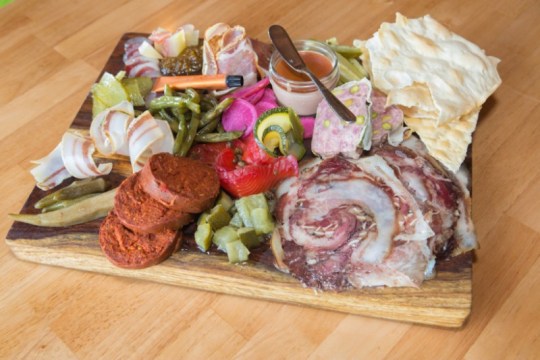
Face bacon & other great cuts ©Root of NOLA 2014
(This image isn’t from River Cottage by the way, but it’s explained below)
* And what is “face bacon, I hear you ask? Here’s a great description from Chef Phillip Lopez, of Root in New Orleans (a restaurant that wasn’t there when we were working in the Crescent City, but reason enough on its own to go back. I’m going to ask if he’d let me apprentice with him):
I gotta say the face bacon. By far, it’s my favorite. It was a crazy idea I had before coming to Root, and I started experimenting with the face. I spent a long time defining this technique. And we utilize the the face bacon in different ways. Of course, it’s on the board, but when we were serving marrow bones, we would make a face bacon jam to go with it. And we always have scraps leftover from slicing, so I asked the bartender for ideas. We came up with this – well, we would render the fat from the face bacon and add it to Bulleit bourbon and sous vide it for 24 hours. Then we’d freeze it, so the fat could be easily separated. Take the fat off, and we have face bacon bourbon! Voila, face bacon manhattan. It’s a little smokey and it’s pretty freaking awesome. The demand for it is so high that we’re making like five bottles of it a week.
And so to work…
A delightful piece of meat, half of a 9 month old, rare breed Oxford Sandy & Black (I’ll be writing up a history of this great breed shortly, for the History pages) is what we all soon started working on. Remember that commercial breeds go to be butchered at only five months. Madness.
Bred on their farm, slaughtered close by a day or so earlier, this couldn’t have been more local or fresher. A lovely piece of meat, with great fat depth & even marbling (as we were to find out) although not quite at the Wagyu beef level but then this is a pig after all, not a cow that’s been raised for close to 36 months before being slaughtered. Anyway, enough, I’ll be doing a piece on Wagyu beef elsewhere at some point.

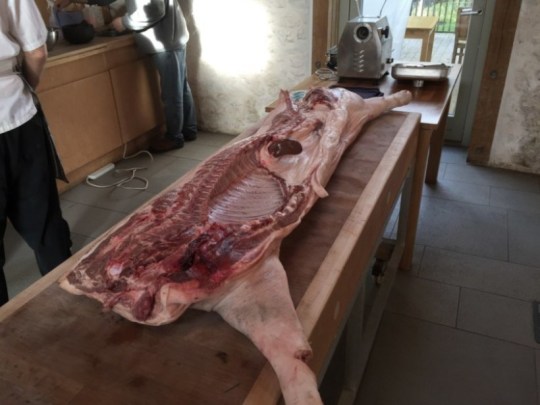
½ a pig at River Cottage
In the background, you’ll see (a) Steve in whites and (b) the meat grinder. The former started work straight away, the latter only came into play an hour or so later. With only half a dozen other people there, it made for a great atmosphere and gave everyone the chance to practice their knife & butchery skills when it came to breaking down the carcase.
Nothing was going to be wasted – “respect the animal” in action.
So with some cursing (certainly on my part when I was asked to remove the skin from a huge side) and much furious knife wielding & regular sharpening by everyone, the carcase was broken down, cut by cut, under Steve’s guidance.
Remembering that “nothing wasn’t to be used”, meant that whilst none of us could claim to have reached Master Butcher standards at any point, that wasn’t important. What was important was that we learnt what the cuts & muscles were and that every piece of meat & bone was to be utilised, either by us in the charcuterie or by the chefs for stock & sausages.
I’ve no ‘photos of the resultant pieces, sorry, far too busy listening to Steve describe what we’d be doing with them later.
We ate everything that we worked on — thank the deity that I’m not doing this course every day or I’d be the size of the side of a house within a week.
This rather attractive grouping of salami was produced by everyone. The first one was actually produced by me, although how you’d know, I’ve no idea.

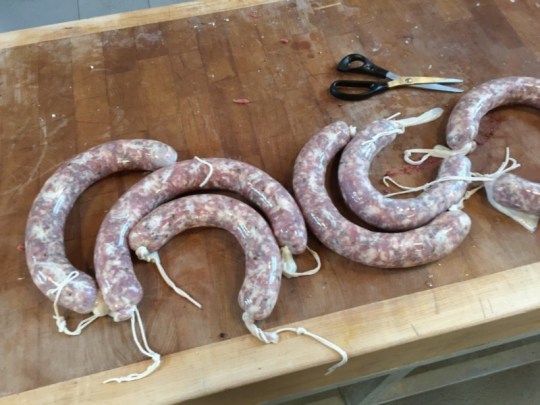
Salami. That’s it.
And here, courtesy of Steve & River Cottage, is how we went about the first part of this process:
To get the right texture, it’s very important that the back fat is diced extremely finely. It does take time, but it’s worth it. It’s a good idea to freeze the fat first, which makes it easier to cut.
Ingredients: Makes about 15 salamis
6 metres of beef runners or beef middles
2.6 kg lean pork from the shoulder, minced on an 8mm plate
400g back fat, cut into 2mm dice
1-2 cloves of garlic, peeled and very finely chopped
Freshly ground black pepper, to taste
1-2 glasses of red wine
60g salt
Malt vinegar and olive oil, to finish
Before you get to work on your salami mix, put the beef runners to soak in a large bowl of fresh water. Slosh them about to rinse off the salt then leave them to soak overnight. When they are slippery, flexible and completely rinsed of salt, they are ready to use.
Mix together all the other ingredients (except the vinegar and oil) – with your bare (but clean) hands, if you like – so that the salt and fat are well distributed throughout the mix. Load up your sausage-making machine with the mix, slide a length of beef runner on to the nozzle, and tie the end of the casing into a knot, as you would tie a balloon. Then tie a short length of butcher’s string in an ordinary granny knot inside the knot. Make a loop with the string so you can hang the sausage up, and tie it again with a second knot in the same place. Stuff the casing with the mix until you have a filled a length of 40–50cm. As you work use a very sharp pin to prick the casing all over. This allows any air to escape and ensures you get a nice, tight salami. Cut off the runner, leaving enough unfilled runner at the end to tie another knot.
Hold up the filled casing with the knotted end at the bottom and squeeze the mixture down the casing gently, so it is nice and tight. Prick it again with the pin as you do this. Then tie another knot in the top of the runner and make another loop with string, just as you did at the other end. The compacted sausage, tied at both ends, will now be 30–40cm long, although you can make shorter ones if you like. It’s useful to have two people on the job for an efficient production line: one to do the filling and cutting, the other to do the knots and hang up the filled runners.
The salamis should be hung individually by the string loops in a cool, well-ventilated place where the temperature is not likely to rise above 12°C. Make sure they are not touching a wall, or each other, and they are not in direct sunlight. Over the coming weeks, a number of moulds, ranging in colour from grey-green to white and even orange, may form on the casings. None of these should worry you but you can wash them off with a cloth soaked in malt vinegar if you wish.
The salami may take anything from 4 to 10 weeks to mature, depending on the conditions and, indeed, on how you like them. They can be tried as soon as they are fairly firm to the touch and dry-looking, but they will continue to dry out and harden until they are practically rock hard. When they reach the stage you like, wipe off any mould from the outside with a cloth soaked in vinegar. Rub the salami with a little olive oil and transfer it to the fridge. Serve your salami in slices 2–3mm thick. If you prefer, peel off the ring of casing from each slice before eating, although it is perfectly safe to eat.
The rest of the day was a whirlwind of various cuts, techniques (inc. brining, dry rubbing hot & cold smoking) and flavours and textures. I’d be typing for another day or so to cover everything that Steve showed us. Suffice to say that you need to (a) buy his book (and he signed my copy, that I’d brought along that day, with a smile) or (b) book a day on his course. Or (c) — which is what I’d really recommend — both of these options.

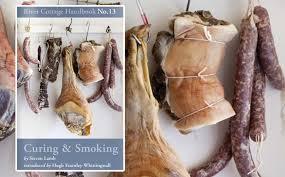
Curing & Smoking: River Cottage Handbook No.13
He’s a hugely passionate, committed and interested tutor and I can’t praise him too highly or underplay just quite how much I enjoyed this day. I came away even more confident that charcuterie is what I love doing and also that there’s nothing to be scared of in either the techniques or in recipes given — just a case of practice, practice, practice and experiment, experiment, experiment. Think of your own additions to the the mixes and rubs and brines and see what they do. They may well work.
And finally? Finally, a shot from inside their temperature & humidity controlled hanging store. If this doesn’t have you drooling over the page and wanting to do your own charcuterie, then nothing will.

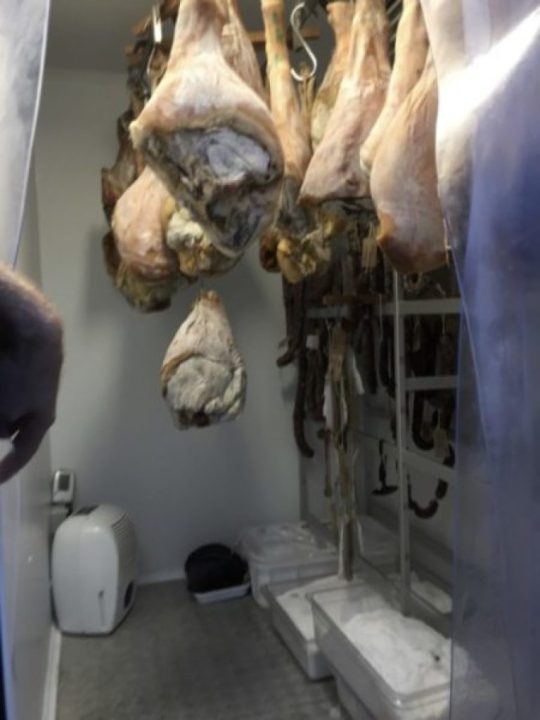
Inside the temple of River Cottage
And finally, finally, a quick shout out to The Whole Hog in Lyme Regis for their dedication to producing just one thing, but that one thing extremely well; a hefty portion of pork pulled off the joint, accompanied by crackling, apple sauce, reduced onions & gravy inna white bun. Kudos guys. It’s great.
Me? I’m off to start work on a 12-month Prosciutto cure. Wish me luck.
Curing & smoking (& sundry other diverse arcana) was originally published on Salute The Pig
0 notes